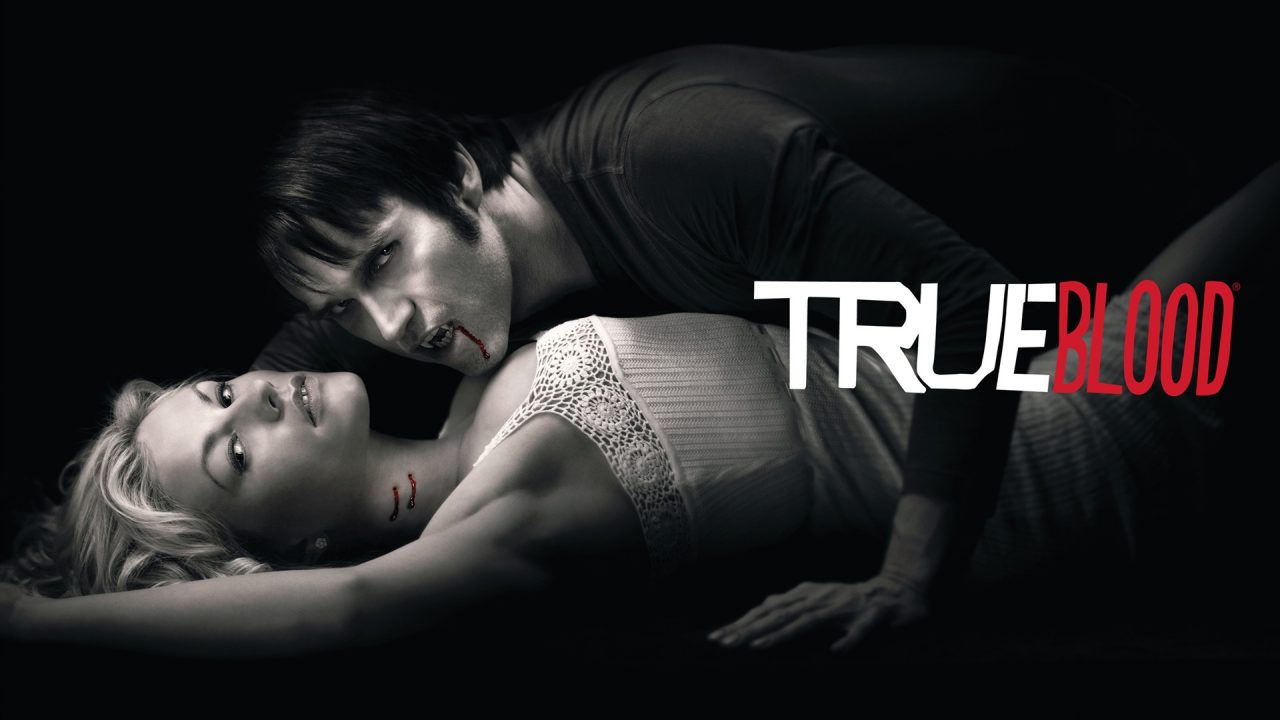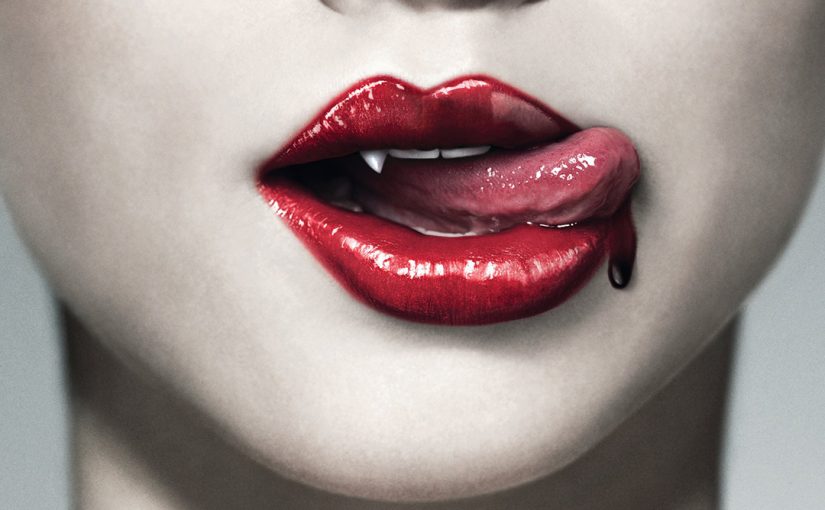I had quite a lot of time on my hands during the New Year’s holidays and a large part of it was most enjoyably spent watching the three full seasons of the True Blood TV show. For those of you so unimaginably uninformed as to not recognize the title, it’s a vampire story in a contemporary urban setting, dealing with the attempts of the vampire minority to blend into mainstream (human) society. I was so enraptured with the show that I went on and read the first three novels of the Southern Vampire Mysteries series by C. Harris, which the show is based upon. By convenient coincidence, there were so many vampire-related movies on TV during the holidays that I felt I needed to complete the circle by finally watching the Twilight movies, which I shun for a long time for suspicion of being a sentimental teenager romance. The exercise has left my indulgent, eager mind completely immersed in modern vampire lore and melodramatic romances.
Now, a comparison between True Blood and Twilight may seem a bit… unfair. I have the feeling that the target audiences are divided by a gap of at least twenty years of age: while True Blood is violent, sexy, bloody and deranged (often all at the same time), Twilight is clean, politically correct, safe and cheesy. It’s like comparing Disney to Lars von Trier. I don’t think I’d have even thought of it if it weren’t for the Wikipedia article on the Twilight novels, where there was quoted an entirely ridiculous claim by the author that the first novel was inspired by Austin’s Pride and Prejudice (which I happened to be reading at the time and was therefore shocked by the insanity of the notion), the second on Shakespeare’s Romeo and Juliet, the third on Bronte’s Wuthering Heights and the final on Shakespeare’s Midsummer Night’s Dream. Ahem. If it is fair to put Austin, Shakespeare and Bronte into the same sentence with Twilight, I judge it entirely fair to compare it to True Blood.
But first I want to talk a little about the True Blood novels. There are ten, and while I had not the endurance to read past the third, I read the summaries of the rest carefully so that I have a decent overview of the entire series. In an otherwise remarkably ordinary and seemingly realistic setting of the deep south of USA, the vampires have revealed their existence after the invention of synthetic blood which made it possible for them to try and coexist peacefully with humans. The story revolves around the adventures of one Sookie Stackhouse, a sexy waitress from a small town in Louisiana, as she is involved, ever more deeply, in the goings on of the supernatural world (of which the vampires are but a small part). Sookie is, however, no stranger to the supernatural, being herself born a telepath. At first, she considers her strange gift a disability because it has effectively made it impossible for her to develop a normal social and sexual life. So when she meets her first vampire, Bill Compton, and discovers that she can’t read his mind, she eagerly and readily falls in love with him.

Although the novels are nominally mysteries, with strange events in the beginning and explanations in the end, I have not been able to ignore the naiveté of these “mystery plots”, which range from silly to ludicrous. They are of no consequence other than to artificially accelerate character development and provide motivation for the most dramatic scenes; and if they weren’t absurd, devoid of logic and unsupported by discernible evidence, it would have been just as well. As it is, I am convinced that a surgical removal of the mysteries would affect nothing but the page count.
It was the story about the troubled inter-species relationship between Sookie and Bill that kept me reading; a story where trust and immutable attraction keep the severe differences in needs, values and behavior in an uneasy balance. At first I liked both lead characters, and Bill I kept liking because the author kept him consistent. Sookie, on the other hand, devolved from a relatively original character into a slutty kind of Mary Sue, and each of the three novels introduces a new extraordinarily handsome supernatural male endowed with all imaginable love-making proficiencies, who must instantly desire her. I had the distinct impression that the author quickly grew bored with Bill’s steady, old-fashioned, serious, and deliciously flawed character, so Sookie’s affections were gradually steered towards the chief competitor, another vampire, named Eric, and later to others. When I first read the summaries of the later novels and discovered that the original love story is never actually resolved into a lasting relationship, but instead broken off for the sake of new love interests, I lost my only reason to read on.
Apart from the silly mysteries and the central love story, there is really little to say about the books except that on occasion it was embarrassingly obvious that they were written by a woman, and as an expression of mundane depravities. Unvaryingly detailed enumerations of the apparel every character is wearing (down to the color of the shoes or nail polish), with frequent reminders of just how sexy Sookie and all her long- and short-term love interests are, or how good a kissing technique a thousand years old vampire must have, to the inclusion of an anatomically accurate description of how exactly Bill made sure she wouldn’t ache after their first love making, drag the novels down yet a couple more notches. At times is’s hardly any better than average fanfiction.
You’re probably wondering why I read any of it if it was so abominable. Well, my primary motivation was to find where the TV show diverged from the books and to try to ascertain why – especially on the points where I thought the show itself was indulging too much to melodramatic tendencies. You see, on account of the show I have only a few criticisms and in general I think it’s extraordinary. It’s a rare example of how a story can be immensely improved through the act of filming, by virtue of cutting out the unnecessary, underlining what’s really important, giving proper weight to deserving characters and situations, and shifting the perspective to an omniscient narrator (the books are all told from Sookie’s perspective, in first person). Many support characters from the books were developed into an interesting and funny cast that elevates the story further. The more I think about it the more it amazes me: how tiny tricks, minute cuts and additions, result in a metamorphosis from a shitty piece of trash fiction into a masterpiece of television production. Because I’m ready to put True Blood the show right there with my all-time favorites: Battlestar Galactica, Spartacus and House, no question about that.
The first season follows the events from the first book in the series rather closely, but in such a superior manner that I’m at a loss as to how to make it tangible. The acting is superb and there are no exceptions from that rule to break the immersion. Particular praise must be laid on the two leads, Anna Paquin (Sookie) and Steven Moyer (Bill Compton); there’s such chemistry between them, such honesty, such electricity – it adds a whole new meaning to the word perfect. (Later on I found out that the actors actually fell in love while filming the show and got married.) The other characters are portrayed equally well, and the direction is spot on, showing always that which is the most interesting, that which conveys the most meaning, that which has the highest amount of emotional content. There are no empty scenes, no purposeless dialog, every minute of the show drives the story forward, making you ever more curious about what happens next.

Look at what Twilight offers in comparison. Bella, the lead female, looks and speaks like she’s brain-damaged. She can’t put a whole sentence together, it’s all mmmhhhmmms and ahhhemmms and stuttering and mumbling. She never looks anyone in the eye and doesn’t seem to have any characteristics whatsoever. Was that supposed to be likable? There isn’t a single scene in the movie that doesn’t show her putting her unremarkable hair behind her unremarkable ears and trying to “act” with her pale, unremarkable face while pointlessly flapping her unremarkable eyelashes. Why on earth would anyone find her interesting is beyond me. Nothing is shown that would set her apart from the other stupid teenagers she shares her screen-time with – no strange or commendable attitudes, no special freedom (or for that matter, inhibition) with which she speaks her mind, the only thing that seems special about her is her clumsiness, which isn’t even funny. Next to Sookie’s unusual abilities, surprising openness, intelligence and bravery, next to an interesting and expressive face to look at and the incredible range of emotion the actress seems able to deliver effortlessly, Bella’s boring, slow, silent and bland character not only falls flat, it’s like a sad old popped chew-gum baloon disintegrating on the sidewalk.
The lead male of the Twilight saga isn’t as much infuriating. He isn’t much of anything. He claims to be seventeen in human years, but looks at least 25; his face is unattractive, and his eyes inexpressive. His acting is average – not as annoying as that of his female counterpart, but there’s nothing to be felt between them that isn’t spelled out in the script. So he plays a moderately old vampire named Edward, who for some inexplicable reason enjoys going to high school over and over. That’s so stupid I can’t even bring myself to comment on it. And it’s there, in school, where the two meet. Unlike the immense energy subdued in the short and not too verbose scene where Sookie first meets Bill, where they devour each other with their eyes so that there’s nothing the show can throw at you later that could possibly make you suspect the mutual attraction, the scene where Bella meets Edward is awkward, and ugly, and is supposed to put the audience in a state of suspense by showing how she apparently has such a revolting odor that he can’t sit still in her presence and has to run away. I kid you not.
In the setting of the Twilight saga, vampires seem to be some sort of crystalline beings – they glitter in the sun (but don’t burn up or anything like that), and they can be shattered. They feed on human blood, but interestingly, they don’t sport fangs. Fangs are a big thing in True Blood, because a vampire normally keeps them retracted and then they pop out when he or she is hungry, excited or sexually aroused. It’s a great plot device that serves to emphasize on some key points of the setting: that vampires are creatures fueled by lust, and that there’s a strong association between sex, violence and feeding. These elements might not be to everyone’s taste, but art usually isn’t, and when it starts catering for all possible tastes, it ceases being art and becomes mainstream bullshit. Twilight is, by all means, trying very hard to bring a theme that only gets interesting in its grimiest and goriest full, to the vulnerable teenager audience, who are no strangers to seeing heads ripped off, but who would surely lose their minds and start massacring their friends if they were to be subjected to the sight of a single female nipple.

good article but ‘retarded’ is ableist and shouldn’t be used as an insult
Indeed. I revised the statements where this word appeared. Thank you for visiting and taking the time to comment. :)